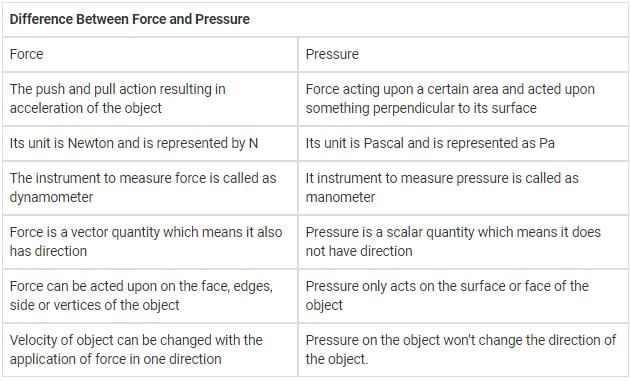Class 8 Exam > Class 8 Questions > What is difference between force and pressure...
Start Learning for Free
What is difference between force and pressure?
Verified Answer
What is difference between force and pressure?

 This question is part of UPSC exam. View all Class 8 courses
This question is part of UPSC exam. View all Class 8 courses
Most Upvoted Answer
What is difference between force and pressure?
Force vs Pressure
Force and pressure are two concepts in physics that are often confused with each other. Let's break down the key differences between these two terms:
Definition:
- Force: Force is a push or pull that acts on an object due to its interaction with another object. It is a vector quantity, meaning it has both magnitude and direction.
- Pressure: Pressure is the force applied perpendicular to the surface of an object per unit area. It is a scalar quantity, only having magnitude.
Units:
- Force: The SI unit of force is the newton (N), which is equivalent to kg*m/s^2.
- Pressure: The SI unit of pressure is the pascal (Pa), which is equivalent to N/m^2.
Direction:
- Force: Force has a specific direction in which it acts on an object.
- Pressure: Pressure does not have a specific direction, as it is evenly distributed over the surface area.
Effect on Objects:
- Force: A force can cause an object to accelerate, deform, or change its state of motion.
- Pressure: Pressure can cause compression or expansion of an object, depending on the direction of the force applied.
In summary, force is a vector quantity that represents a push or pull acting on an object, while pressure is a scalar quantity that represents the force applied per unit area on an object's surface. Understanding the distinction between force and pressure is crucial in physics and engineering applications.
Force and pressure are two concepts in physics that are often confused with each other. Let's break down the key differences between these two terms:
Definition:
- Force: Force is a push or pull that acts on an object due to its interaction with another object. It is a vector quantity, meaning it has both magnitude and direction.
- Pressure: Pressure is the force applied perpendicular to the surface of an object per unit area. It is a scalar quantity, only having magnitude.
Units:
- Force: The SI unit of force is the newton (N), which is equivalent to kg*m/s^2.
- Pressure: The SI unit of pressure is the pascal (Pa), which is equivalent to N/m^2.
Direction:
- Force: Force has a specific direction in which it acts on an object.
- Pressure: Pressure does not have a specific direction, as it is evenly distributed over the surface area.
Effect on Objects:
- Force: A force can cause an object to accelerate, deform, or change its state of motion.
- Pressure: Pressure can cause compression or expansion of an object, depending on the direction of the force applied.
In summary, force is a vector quantity that represents a push or pull acting on an object, while pressure is a scalar quantity that represents the force applied per unit area on an object's surface. Understanding the distinction between force and pressure is crucial in physics and engineering applications.

|
Explore Courses for Class 8 exam
|

|
Question Description
What is difference between force and pressure? for Class 8 2025 is part of Class 8 preparation. The Question and answers have been prepared according to the Class 8 exam syllabus. Information about What is difference between force and pressure? covers all topics & solutions for Class 8 2025 Exam. Find important definitions, questions, meanings, examples, exercises and tests below for What is difference between force and pressure?.
What is difference between force and pressure? for Class 8 2025 is part of Class 8 preparation. The Question and answers have been prepared according to the Class 8 exam syllabus. Information about What is difference between force and pressure? covers all topics & solutions for Class 8 2025 Exam. Find important definitions, questions, meanings, examples, exercises and tests below for What is difference between force and pressure?.
Solutions for What is difference between force and pressure? in English & in Hindi are available as part of our courses for Class 8.
Download more important topics, notes, lectures and mock test series for Class 8 Exam by signing up for free.
Here you can find the meaning of What is difference between force and pressure? defined & explained in the simplest way possible. Besides giving the explanation of
What is difference between force and pressure?, a detailed solution for What is difference between force and pressure? has been provided alongside types of What is difference between force and pressure? theory, EduRev gives you an
ample number of questions to practice What is difference between force and pressure? tests, examples and also practice Class 8 tests.

|
Explore Courses for Class 8 exam
|

|
Signup for Free!
Signup to see your scores go up within 7 days! Learn & Practice with 1000+ FREE Notes, Videos & Tests.


















